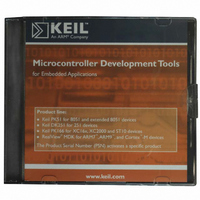MDK-ARM Keil, MDK-ARM Datasheet - Page 113

MDK-ARM
Manufacturer Part Number
MDK-ARM
Description
KIT REALVIEW MCU DEVELOPMENT
Manufacturer
Keil
Type
Compiler and IDEr
Specifications of MDK-ARM
For Use With/related Products
ARM MCUs
Lead Free Status / RoHS Status
Lead free / RoHS Compliant
- Current page: 113 of 156
- Download datasheet (3Mb)
Getting Started: Building Applications with RL-ARM
113
With USB 2.0, peer-to-peer communication is not possible. USB On-The–Go
(OTG) is an extension to the USB 2.0 specification, which directly supports peer-
to-peer communication. For example, allowing pictures stored on a camera to be
transferred directly onto a USB memory stick without the need for a host or other
USB master.
Since the USB network is designed to be “plug and play”, the host has no
knowledge of a new device when it is first plugged onto the network. It first
needs to determine the bit-rate required to communicate to the new device. This
is done by adding a pull-up resistor to either the D+ or D- line. If the D+ line is
pulled up, the host will assume that a full speed device has been added. A pull-
up on D- means low speed. High-speed devices first appear as full speed and
then negotiate up to high speed, once the connection has been established.
USB Pipes And Endpoints
Once a device has been connected to the host and the signaling speed has been
determined, the host can start to transfer data to and from the new device. Data
packets are transferred over a set of logical connections called pipes. A pipe
originates from a buffer in the host. It is connected to a remote device with a
specific device address. The pipe is terminated inside the device at an Endpoint.
In microcontroller terms, the
Endpoint may be viewed as a
hardware buffer where the data is
stored. The Endpoint also
generates an interrupt, which
signals to the Central Processing
Unit (CPU) that a new data
packet has arrived. In the case of
an IN pipe (transferring data into
the host) the Endpoint buffer
must be filled with data. The
host will request this data. Once
the data has been transferred, an
interrupt will be generated and
the CPU or DMA unit must refill
the Endpoint buffer with fresh
data.
Related parts for MDK-ARM
Image
Part Number
Description
Manufacturer
Datasheet
Request
R

Part Number:
Description:
KIT REALVIEW MCU DEVELOPMENT
Manufacturer:
Keil
Datasheet:

Part Number:
Description:
Development Software SUPPORT EXTENSION FOR MDK-ARM-B
Manufacturer:
Keil Software

Part Number:
Description:
Development Software SUPPORT EXTENSION FOR MDK-ARM
Manufacturer:
Keil Software

Part Number:
Description:
KIT REALVIEW MCU DEVELOPMENT
Manufacturer:
Keil
Datasheet:

Part Number:
Description:
Development Software MCU DEV KIT FOR ARM UPG TO FLOATING LIC
Manufacturer:
Keil Tools

Part Number:
Description:
Development Software MCU DEV KIT FOR ARM W/ FLOATING LICENSE
Manufacturer:
Keil Software

Part Number:
Description:
Development Software MCU DEV KIT FOR ARM uVISION & C++ & RTX
Manufacturer:
Keil Tools

Part Number:
Description:
Development Software SUPP LICENSE RENEWAL 90+ DAYS NO TECH SUP
Manufacturer:
Keil Software
Part Number:
Description:
KEIL C-COMPILER INTERNATIONAL
Manufacturer:
Silicon Laboratories Inc

Part Number:
Description:
BOARD EVAL FOR LPC213X ARM MCU
Manufacturer:
NXP Semiconductors
Datasheet:
Part Number:
Description:
K60N512 Keil Tower Kit
Manufacturer:
Freescale Semiconductor
Datasheet:










